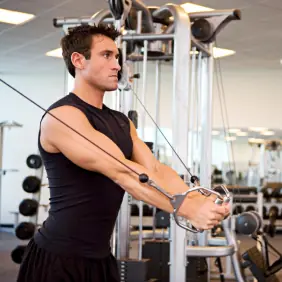
One of the most sought after questions from individuals practicing resistance training is how and when to move up or increase resistance. First, if you are a novice or new to resistance training, I would recommend working on your lifting form and breathing technique. These are two of the most important aspects of weightlifting. Many individuals have horrible form and either hold their breath or reverse it.
A quick tip for breathing is to count underneath your breath. When you count, the sound that you create is by the air being expelled from your lungs and this will help you create a rhythm. Remember, if you are doing a shoulder press, you should breathe out when you push the weight up and breathe in when the weight comes back down.
Now that we got that out of the way, when is the appropriate time to increase your resistance with your weight lifting routine? If you have been doing a certain weight on various muscle groups and you are able to complete the sets and repetitions after two weeks, it is time to increase your resistance. I would suggest increasing your weight by at least 5 percent, but not more than 10 percent. The one great thing about most of the gyms is they have dumbbell weights with incremental increases of 2.5 pounds.
For example if you are increasing from 10 pounds to 12.5 pounds or from 15 pounds to 17.5 pounds, you can use these options without going to a weight that is just too heavy. This percentage increase is for individuals interested in their overall health and who would like to improve their muscle tone, strength, and endurance. Remember, in order to keep getting results with weight lifting, you need to increase your weight. As we age, our bone density and muscle mass decreases, so we want to do our best to keep both as long as we can. Challenging our muscles with incremental weight increases is one good way to do that.
If your goal is to get muscle hypertrophy then that involves a whole different type of lifting technique. Muscle hypertrophy is increasing the size of the muscle, and that happens either for aesthetic reasons or because you are in athletics and that is an outcome of lifting and playing the sport. The technique you are going to implement is the Overload Principle, and this entails incremental increases in weight with every set. In addition, you will want to include burnout sets after the end of your exercises to really fatigue the muscle. You will also need to keep track of sets, reps, weight, rest times and how you were feeling during that lift.
I would also recommend that you either have a workout partner or ask individuals in your gym who can spot or assist you with some of the lifts. You are going to struggle to complete some of the sets, but that is what you want. You want to recruit as much of the muscle fibers as you can in order to create muscle fatigue. This type of lifting is all about challenging the muscle on every set, so you need to always have a person there to assist if you want to get the full impact of the overload principle. The idea is to breakdown the muscle, let it rest and then break it down again. Rest is extremely important because the muscle cannot grow if you keep working it too much (do not do the same muscle group more than twice per week).
Now that you know how to increase your resistance, make sure you are working your muscles to create balance. You do not want to place too much emphasis on a specific muscle groups because it will not only look funny, but it can create imbalances in your body that can cause structural issues and can lead to pain or injury.
 Increase your metabolism and tone up faster. Find a fitness class.
Increase your metabolism and tone up faster. Find a fitness class.
Kisar S. Dhillon is a professional fitness trainer living in Portland, Oregon. He holds a Bachelor of Science Degree in Kinesiology, Post Baccalaureate Studies in Exercise Physiology and a Master's in Business Administration. He has more than 16 years experience in the health and fitness industry and is currently the owner of 1-2-1 Fitness, LLC. You can follow him on Twitter and on YouTube.
Get ACTIVE on the Go


Couch to 5K®
The best way to get new runners off the couch and across the finish line of their first 5K.
Available for iOS | Android





Discuss This Article